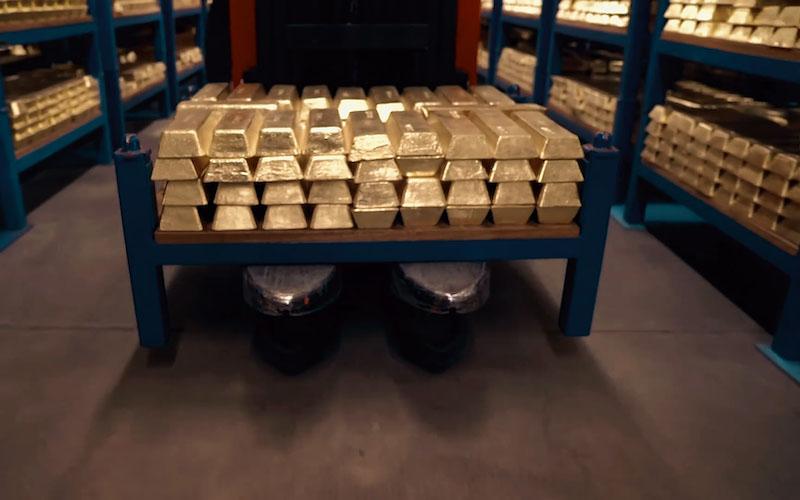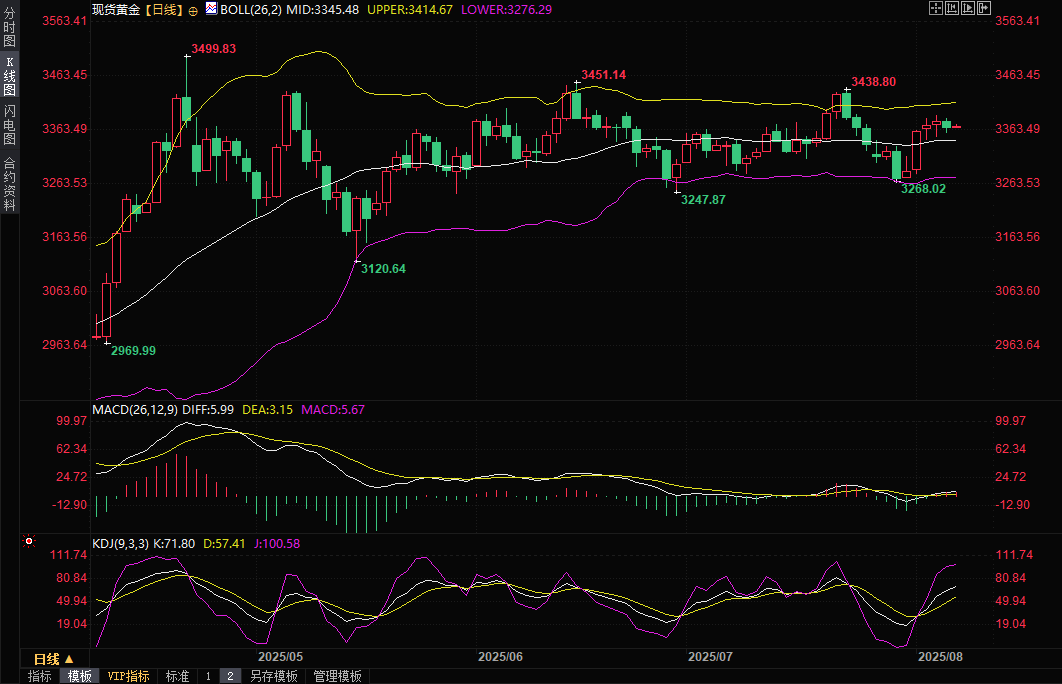Gold trading reminder: Profit-taking triggers a short-term correction in gold prices, pay attention to the impact of three major events
2025-08-07 07:11:45

The driving force behind gold price fluctuations
Profit-taking triggers a short-term pullback
Spot gold prices fell 0.34% on Wednesday to close at $3,369.19 per ounce, having hit a near two-week high of $3,390 the previous day. David Meger, director of metals trading at High Ridge Futures, attributed the decline primarily to profit-taking following recent gains. Gold prices rose for three consecutive days following weak US jobs data last Friday, fueling a surge in risk aversion. However, as economic data entered a relatively quiet period, safe-haven demand waned, prompting some investors to lock in profits, leading to a short-term correction in gold prices. This type of technical correction is not uncommon in the gold market, especially in the absence of major economic catalysts, when prices often come under pressure due to profit-taking.
The game between safe-haven demand and market sentiment
As a traditional safe-haven asset, gold's price is typically supported by global economic uncertainty and geopolitical risks. Market concerns about a US economic slowdown have intensified recently, particularly with July employment data falling far short of expectations and data for the previous two months being significantly revised downward, signaling a weakening labor market. This has not only boosted demand for gold as a safe-haven asset but also shifted market expectations regarding the Federal Reserve's monetary policy. However, as some investors have taken profits, risk aversion has cooled, temporarily stalling gold's upward momentum. Meger further noted that the gold market is currently in a state of equilibrium, supported by the economic slowdown but also under pressure from short-term profit-taking. Future trends will depend on new economic data and the evolution of geopolitical events.
Macroeconomic Background: Expectations of Interest Rate Cuts and Economic Slowdown
Expectations of a Fed rate cut rise
According to the Chicago Mercantile Exchange (CME) FedWatch tool, market expectations for a Federal Reserve rate cut of at least 25 basis points in September have surged to 92%, up from 46.7% a week ago. This shift stems from the weak July jobs report, which showed US job creation fell far short of expectations and saw data for the previous two months revised downward by 258,000, indicating a significant slowdown in the labor market. Minneapolis Fed President Neel Kashkari has explicitly stated that signs of an economic slowdown suggest the Fed may need to cut interest rates in the near term, even predicting two 25 basis point cuts by the end of the year. San Francisco Fed President Mary Daly has expressed similar views, believing that further deterioration in the labor market would be unacceptable and that a rate cut may be imminent.
Rising expectations of interest rate cuts are directly positive for gold prices. Lower interest rates typically reduce the opportunity cost of holding gold and weaken the dollar's appeal, pushing up gold prices. Nevertheless, market concerns about inflationary pressures persist. The latest data from the Institute for Supply Management (ISM) shows slowing growth in the services sector and increasing price pressures, which may limit the magnitude and pace of the Federal Reserve's rate cuts. Federal Reserve Governor Tim Cook noted that the weak latest employment data was "concerning," but emphasized the need for further observation to determine whether inflation is a one-off increase or a persistent pressure. This uncertainty will ensure high volatility in the gold market in the near term.
Constraints on US Treasury Yields and the US Dollar <br/>Meanwhile, the US Treasury market also indirectly influences gold prices. On August 6, the 10-year US Treasury yield rose to 4.224% due to weak demand at a $42 billion auction, ending a four-day losing streak. Higher US Treasury yields typically increase the dollar's appeal, putting pressure on gold prices. However, the US dollar index fell 0.56% to 98.18 on Wednesday, its lowest level since July 28, partially easing downward pressure on gold prices. Market strategist Marc Chandler noted that weak employment data dampened the dollar's rebound momentum, and traders' expectations of the Federal Reserve's interest rate cuts this year further pushed the dollar lower, providing support for gold. However, if US Treasury yields continue to rise, gold's upside may be limited.
The impact of geopolitics and tariff storms
Trump's tariff policy exacerbates market uncertainty
The Trump administration's trade policies have become a key variable influencing the gold market. On August 6, Trump signed an executive order imposing an additional 25% tariff on Indian goods, citing India's continued imports of Russian oil. This move, which resulted in tariffs of up to 50% on some Indian goods, has strained US-India relations. India's Ministry of External Affairs expressed "deep regret" and emphasized that its energy procurement decisions are based on market demand and national interests. Meanwhile, Trump threatened to impose tariffs of up to 39% on Swiss goods, despite urgent mediation efforts by Swiss President Keller-Sutter, who failed to reach a compromise. These tariffs not only disrupt global trade but also exacerbate geopolitical risks, driving up demand for gold as a safe haven.
Despite "significant progress" in the meeting between Trump's special envoy, Vitkov, and Russian President Vladimir Putin, the White House still plans to impose secondary sanctions on Russia on August 8. This complex geopolitical game has further heightened market uncertainty. Meger noted that concerns about Russian sanctions have previously supported platinum and palladium prices, while gold, as a broader safe-haven asset, has also benefited from geopolitical tensions. However, Trump's tariff actions on India and Switzerland could trigger a chain reaction. For example, hindered Indian exports to the US could weaken its economic growth, further impacting the outlook for global economic recovery, posing a potential challenge to long-term gold demand.
US-China trade negotiations and the global economic outlook
The US-China trade relationship is also a focus of attention in the gold market. US Treasury Secretary Benson warned that continued purchases of Russian oil could result in new tariffs. The US and China are currently trying to extend a 90-day tariff truce that expires on August 12th, but if negotiations fail, bilateral tariffs could rise to triple-digit levels. This uncertainty could further fuel safe-haven demand for gold. It's worth noting that China, as one of the world's largest gold consumers, has a significant impact on the gold market due to its economic performance. Any escalation in US-China trade frictions could weaken China's economic recovery, indirectly impacting gold demand.
Focus on the impact of three major events in the future market
Trump plans to impose a 100% tariff on chips, but Apple and other companies relocating to the US will be exempted . Trump plans to impose a 100% tariff on imported semiconductors and other products, but has pledged to exempt companies that relocate production to the US. While announcing $100 billion in new investments with Apple CEO Tim Cook, he said companies would not be subject to tariffs as long as they produce or commit to building factories in the US. This move is intended to stimulate US manufacturing and employment.
Trump announces additional secondary sanctions on Russia
On August 6, Trump announced he would impose additional secondary sanctions on Russia. Previously, on July 29, he set a 10-day deadline for Russia and Ukraine to reach a peace agreement, threatening new sanctions. Currently, the negotiation deadline is set for August 8.
Swiss President's mediation fails, US 39% tariffs will take effect
Swiss President Kellerszuter traveled to the United States to try to lower the 39% tariff on Swiss exports, but to no avail. The United States is Switzerland's largest export market. Kellerszuter met with US Secretary of State Rubio but was not received by Trump or senior trade officials. The US rejected Switzerland's request for a 10% tariff and reiterated its goal of reducing the trade deficit.
In addition, we also need to pay attention to changes in the number of initial jobless claims in the United States, the Bank of England's interest rate decision and speeches by Federal Reserve officials on this trading day.
Overall, the gold market may continue to face short-term pressure from profit-taking and a technical correction, but expectations of a Fed rate cut, geopolitical risks, and a weakening US dollar provide solid long-term support for gold prices. Market bets on a September rate cut are nearly certain, and dovish statements from Fed policymakers have further reinforced this expectation. Furthermore, uncertainty surrounding Trump's tariff policies and Fed personnel changes will continue to provide a safe-haven premium for gold. However, if US Treasury yields continue to rise or the global economic recovery exceeds expectations, the upside for gold prices may be limited.

(Spot gold daily chart, source: Yihuitong)
At 07:09 Beijing time, spot gold was trading at $3,370.39 per ounce.
- Risk Warning and Disclaimer
- The market involves risk, and trading may not be suitable for all investors. This article is for reference only and does not constitute personal investment advice, nor does it take into account certain users’ specific investment objectives, financial situation, or other needs. Any investment decisions made based on this information are at your own risk.





















